The Australian Economy: Stable Equilibrium, Intervention, and Analysis
VerifiedAdded on 2020/06/06
|6
|1361
|40
Report
AI Summary
This report examines the concept of stable economic equilibrium and its relevance to the Australian economy. It begins by defining economic equilibrium as the intersection of market demand and supply, illustrating this with a graphical representation. The report then analyzes the application of this concept in Australia, a capitalist economy, where market forces primarily drive economic decisions. It acknowledges that while the free market generally satisfies the conditions for stable equilibrium, external factors can shift the demand and supply curves, leading to changes in equilibrium. Furthermore, the report discusses the necessity of governmental intervention in production and income distribution, especially during economic fluctuations. The report then analyzes key economic indicators like GDP growth, inflation, and unemployment in Australia, concluding that while labor productivity is increasing, inflation poses a challenge, and recommending policies to control inflation and boost economic stability. References include academic journals and online resources.
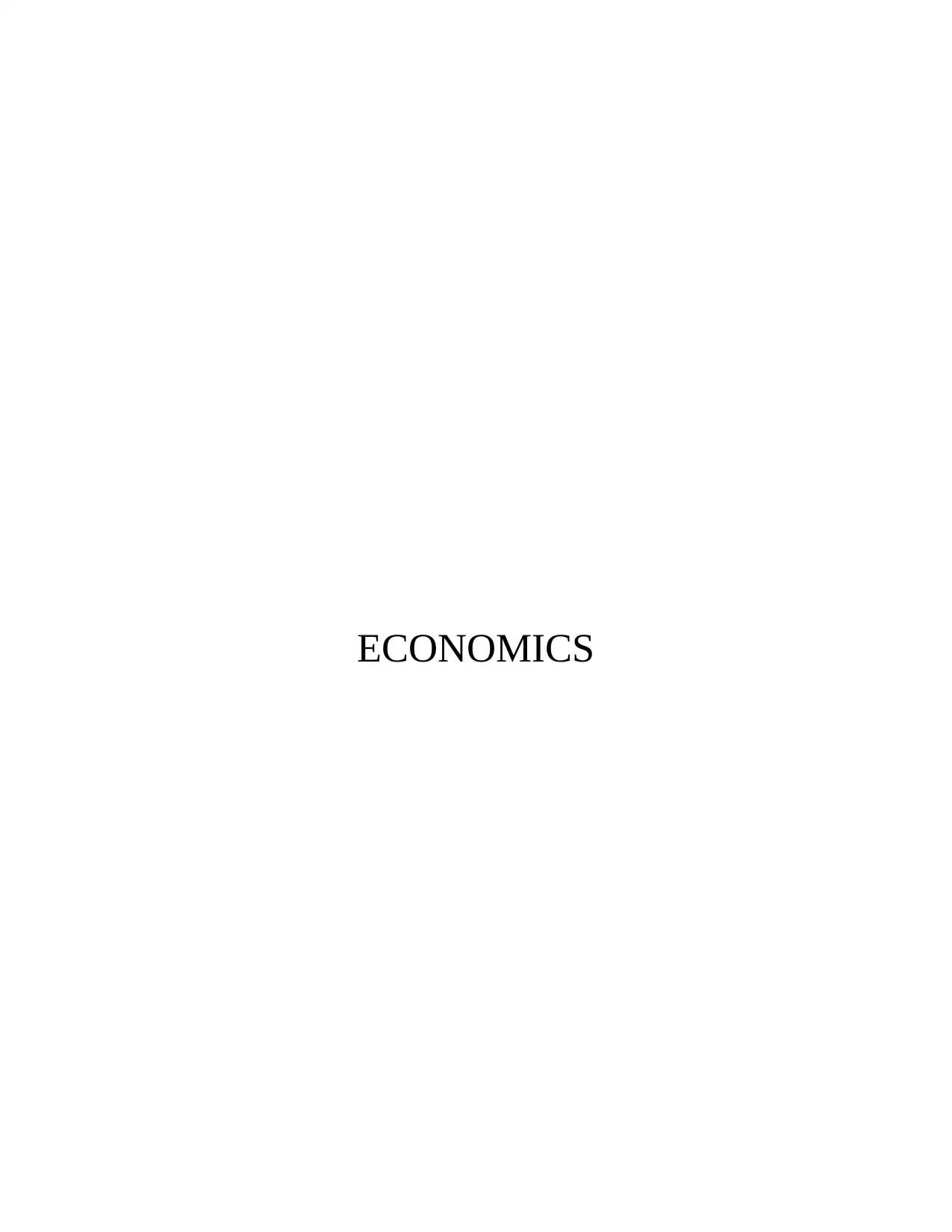
ECONOMICS
Paraphrase This Document
Need a fresh take? Get an instant paraphrase of this document with our AI Paraphraser
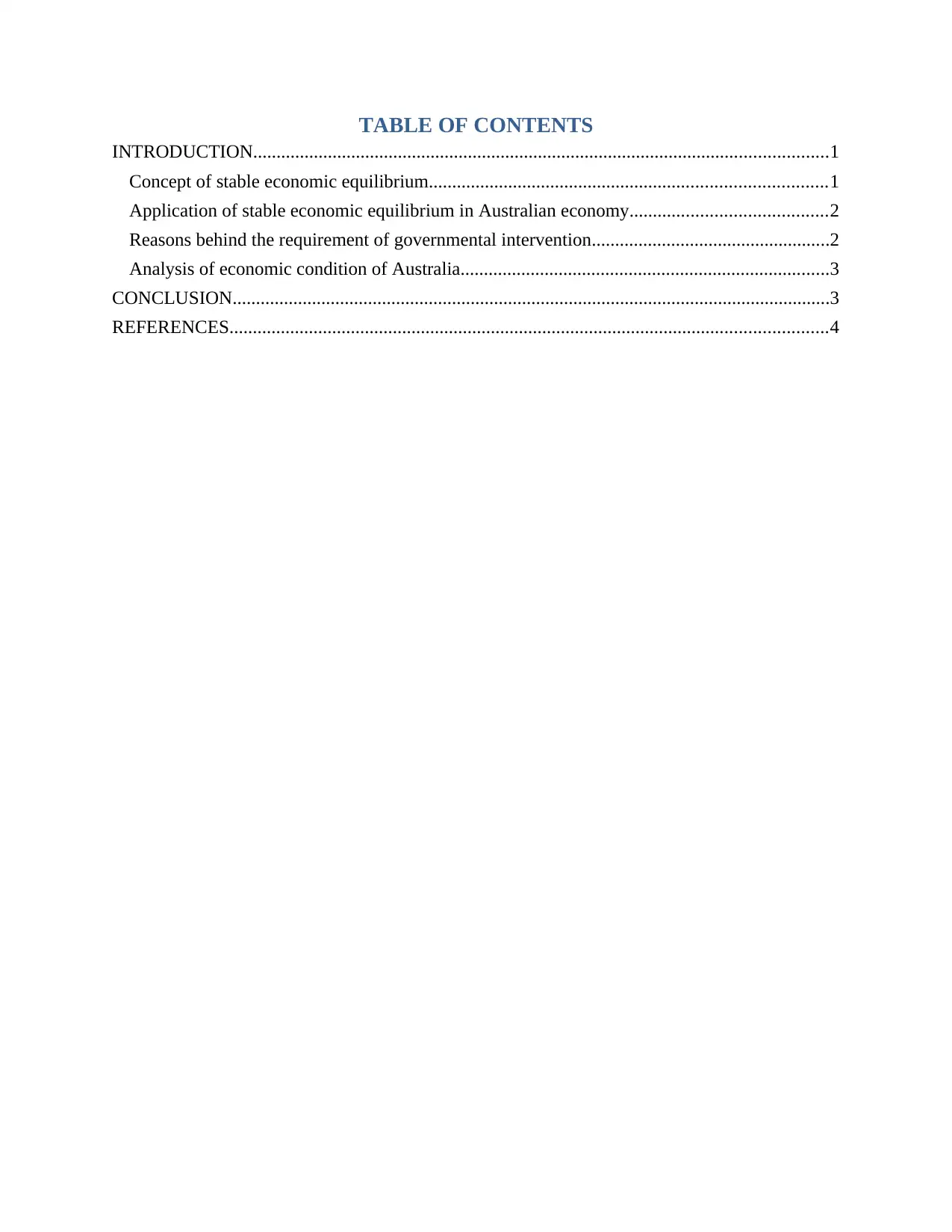
TABLE OF CONTENTS
INTRODUCTION...........................................................................................................................1
Concept of stable economic equilibrium.....................................................................................1
Application of stable economic equilibrium in Australian economy..........................................2
Reasons behind the requirement of governmental intervention...................................................2
Analysis of economic condition of Australia...............................................................................3
CONCLUSION................................................................................................................................3
REFERENCES................................................................................................................................4
INTRODUCTION...........................................................................................................................1
Concept of stable economic equilibrium.....................................................................................1
Application of stable economic equilibrium in Australian economy..........................................2
Reasons behind the requirement of governmental intervention...................................................2
Analysis of economic condition of Australia...............................................................................3
CONCLUSION................................................................................................................................3
REFERENCES................................................................................................................................4
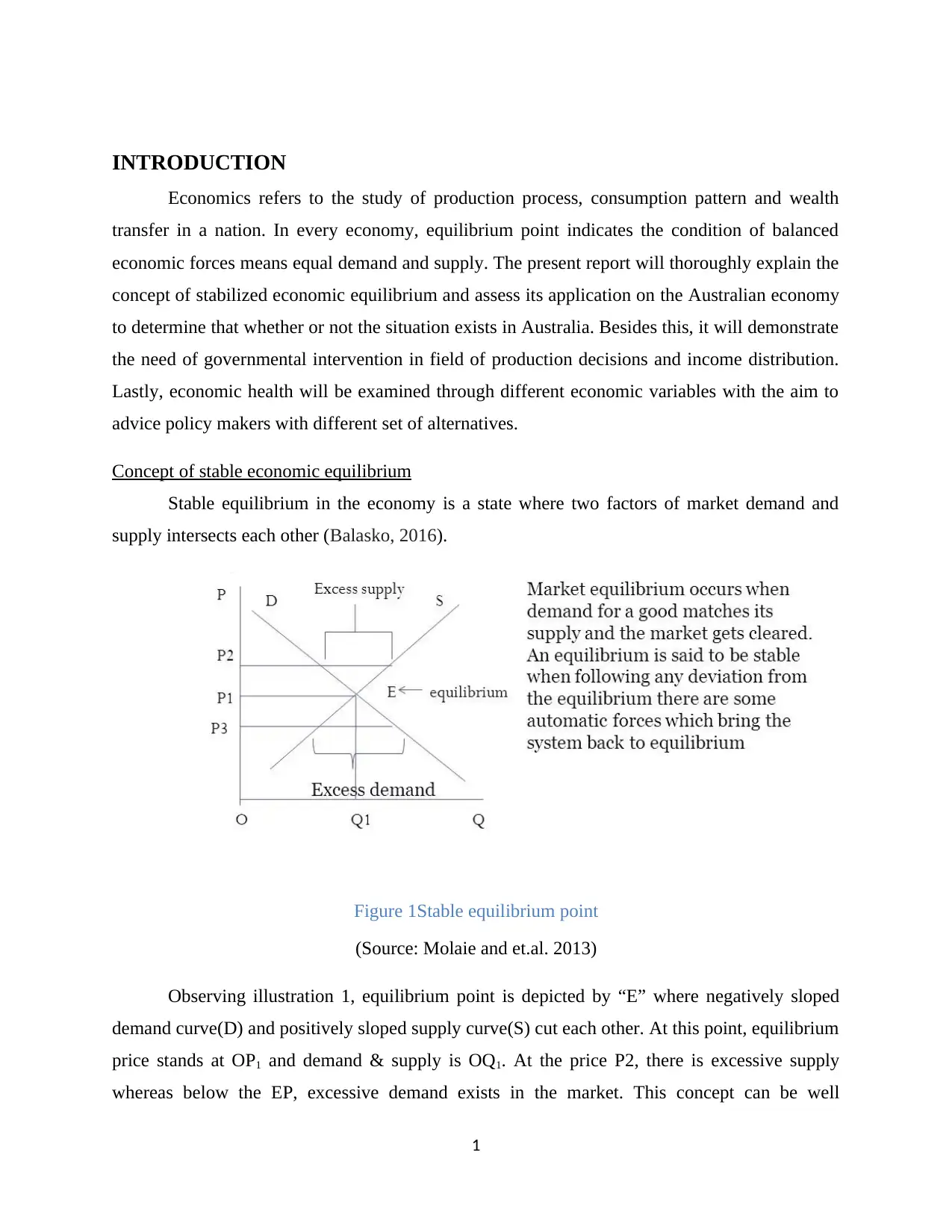
INTRODUCTION
Economics refers to the study of production process, consumption pattern and wealth
transfer in a nation. In every economy, equilibrium point indicates the condition of balanced
economic forces means equal demand and supply. The present report will thoroughly explain the
concept of stabilized economic equilibrium and assess its application on the Australian economy
to determine that whether or not the situation exists in Australia. Besides this, it will demonstrate
the need of governmental intervention in field of production decisions and income distribution.
Lastly, economic health will be examined through different economic variables with the aim to
advice policy makers with different set of alternatives.
Concept of stable economic equilibrium
Stable equilibrium in the economy is a state where two factors of market demand and
supply intersects each other (Balasko, 2016).
Figure 1Stable equilibrium point
(Source: Molaie and et.al. 2013)
Observing illustration 1, equilibrium point is depicted by “E” where negatively sloped
demand curve(D) and positively sloped supply curve(S) cut each other. At this point, equilibrium
price stands at OP1 and demand & supply is OQ1. At the price P2, there is excessive supply
whereas below the EP, excessive demand exists in the market. This concept can be well
1
Economics refers to the study of production process, consumption pattern and wealth
transfer in a nation. In every economy, equilibrium point indicates the condition of balanced
economic forces means equal demand and supply. The present report will thoroughly explain the
concept of stabilized economic equilibrium and assess its application on the Australian economy
to determine that whether or not the situation exists in Australia. Besides this, it will demonstrate
the need of governmental intervention in field of production decisions and income distribution.
Lastly, economic health will be examined through different economic variables with the aim to
advice policy makers with different set of alternatives.
Concept of stable economic equilibrium
Stable equilibrium in the economy is a state where two factors of market demand and
supply intersects each other (Balasko, 2016).
Figure 1Stable equilibrium point
(Source: Molaie and et.al. 2013)
Observing illustration 1, equilibrium point is depicted by “E” where negatively sloped
demand curve(D) and positively sloped supply curve(S) cut each other. At this point, equilibrium
price stands at OP1 and demand & supply is OQ1. At the price P2, there is excessive supply
whereas below the EP, excessive demand exists in the market. This concept can be well
1
⊘ This is a preview!⊘
Do you want full access?
Subscribe today to unlock all pages.

Trusted by 1+ million students worldwide
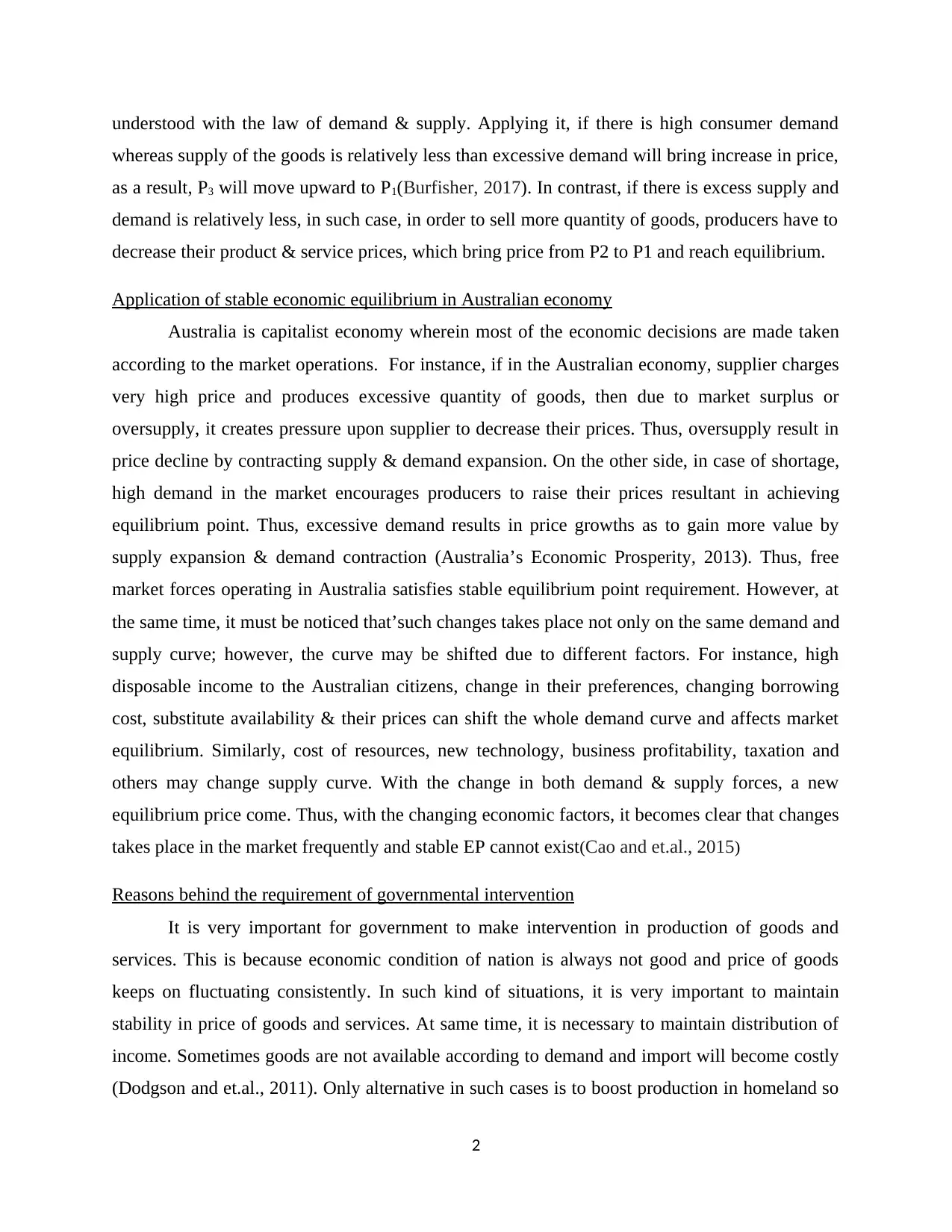
understood with the law of demand & supply. Applying it, if there is high consumer demand
whereas supply of the goods is relatively less than excessive demand will bring increase in price,
as a result, P3 will move upward to P1(Burfisher, 2017). In contrast, if there is excess supply and
demand is relatively less, in such case, in order to sell more quantity of goods, producers have to
decrease their product & service prices, which bring price from P2 to P1 and reach equilibrium.
Application of stable economic equilibrium in Australian economy
Australia is capitalist economy wherein most of the economic decisions are made taken
according to the market operations. For instance, if in the Australian economy, supplier charges
very high price and produces excessive quantity of goods, then due to market surplus or
oversupply, it creates pressure upon supplier to decrease their prices. Thus, oversupply result in
price decline by contracting supply & demand expansion. On the other side, in case of shortage,
high demand in the market encourages producers to raise their prices resultant in achieving
equilibrium point. Thus, excessive demand results in price growths as to gain more value by
supply expansion & demand contraction (Australia’s Economic Prosperity, 2013). Thus, free
market forces operating in Australia satisfies stable equilibrium point requirement. However, at
the same time, it must be noticed that’such changes takes place not only on the same demand and
supply curve; however, the curve may be shifted due to different factors. For instance, high
disposable income to the Australian citizens, change in their preferences, changing borrowing
cost, substitute availability & their prices can shift the whole demand curve and affects market
equilibrium. Similarly, cost of resources, new technology, business profitability, taxation and
others may change supply curve. With the change in both demand & supply forces, a new
equilibrium price come. Thus, with the changing economic factors, it becomes clear that changes
takes place in the market frequently and stable EP cannot exist(Cao and et.al., 2015)
Reasons behind the requirement of governmental intervention
It is very important for government to make intervention in production of goods and
services. This is because economic condition of nation is always not good and price of goods
keeps on fluctuating consistently. In such kind of situations, it is very important to maintain
stability in price of goods and services. At same time, it is necessary to maintain distribution of
income. Sometimes goods are not available according to demand and import will become costly
(Dodgson and et.al., 2011). Only alternative in such cases is to boost production in homeland so
2
whereas supply of the goods is relatively less than excessive demand will bring increase in price,
as a result, P3 will move upward to P1(Burfisher, 2017). In contrast, if there is excess supply and
demand is relatively less, in such case, in order to sell more quantity of goods, producers have to
decrease their product & service prices, which bring price from P2 to P1 and reach equilibrium.
Application of stable economic equilibrium in Australian economy
Australia is capitalist economy wherein most of the economic decisions are made taken
according to the market operations. For instance, if in the Australian economy, supplier charges
very high price and produces excessive quantity of goods, then due to market surplus or
oversupply, it creates pressure upon supplier to decrease their prices. Thus, oversupply result in
price decline by contracting supply & demand expansion. On the other side, in case of shortage,
high demand in the market encourages producers to raise their prices resultant in achieving
equilibrium point. Thus, excessive demand results in price growths as to gain more value by
supply expansion & demand contraction (Australia’s Economic Prosperity, 2013). Thus, free
market forces operating in Australia satisfies stable equilibrium point requirement. However, at
the same time, it must be noticed that’such changes takes place not only on the same demand and
supply curve; however, the curve may be shifted due to different factors. For instance, high
disposable income to the Australian citizens, change in their preferences, changing borrowing
cost, substitute availability & their prices can shift the whole demand curve and affects market
equilibrium. Similarly, cost of resources, new technology, business profitability, taxation and
others may change supply curve. With the change in both demand & supply forces, a new
equilibrium price come. Thus, with the changing economic factors, it becomes clear that changes
takes place in the market frequently and stable EP cannot exist(Cao and et.al., 2015)
Reasons behind the requirement of governmental intervention
It is very important for government to make intervention in production of goods and
services. This is because economic condition of nation is always not good and price of goods
keeps on fluctuating consistently. In such kind of situations, it is very important to maintain
stability in price of goods and services. At same time, it is necessary to maintain distribution of
income. Sometimes goods are not available according to demand and import will become costly
(Dodgson and et.al., 2011). Only alternative in such cases is to boost production in homeland so
2
Paraphrase This Document
Need a fresh take? Get an instant paraphrase of this document with our AI Paraphraser
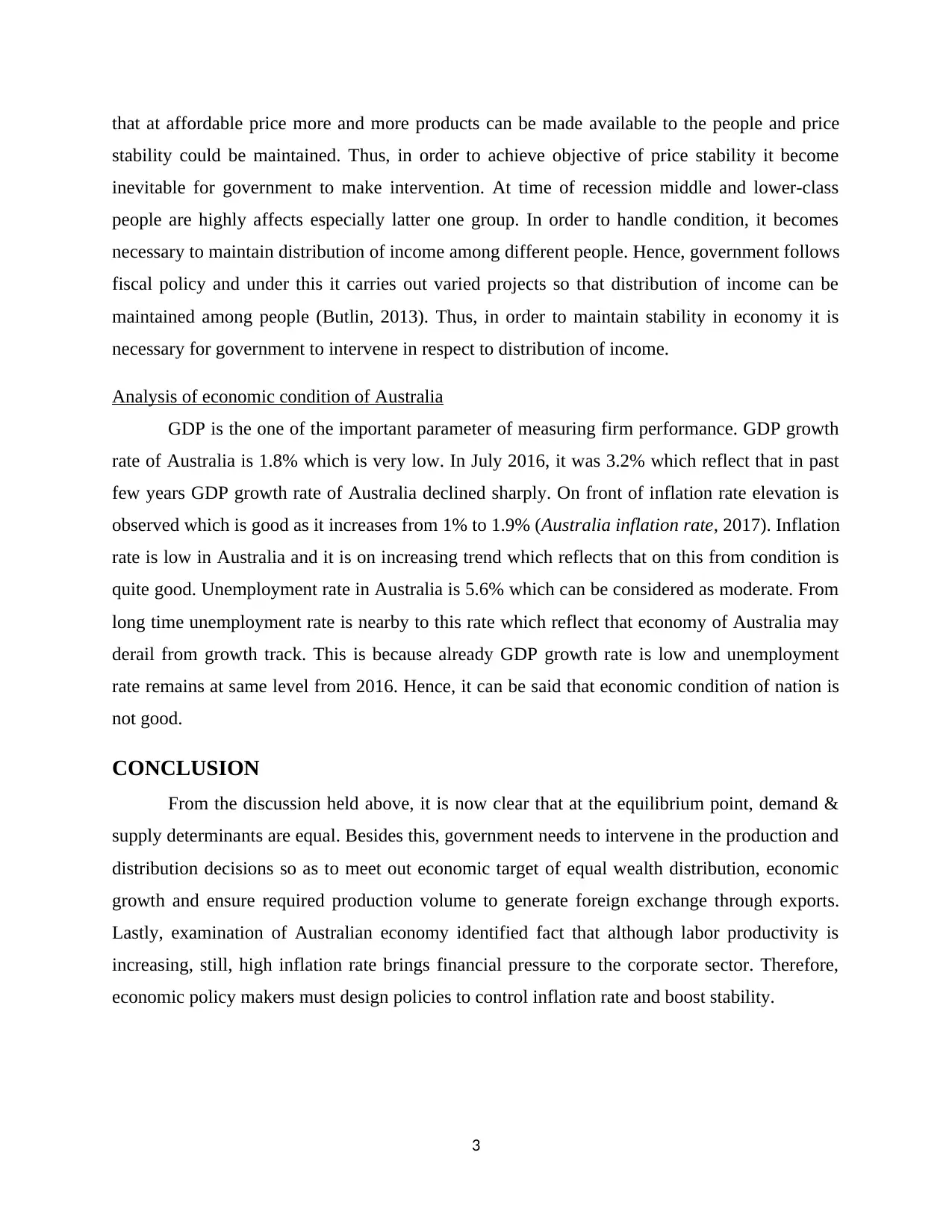
that at affordable price more and more products can be made available to the people and price
stability could be maintained. Thus, in order to achieve objective of price stability it become
inevitable for government to make intervention. At time of recession middle and lower-class
people are highly affects especially latter one group. In order to handle condition, it becomes
necessary to maintain distribution of income among different people. Hence, government follows
fiscal policy and under this it carries out varied projects so that distribution of income can be
maintained among people (Butlin, 2013). Thus, in order to maintain stability in economy it is
necessary for government to intervene in respect to distribution of income.
Analysis of economic condition of Australia
GDP is the one of the important parameter of measuring firm performance. GDP growth
rate of Australia is 1.8% which is very low. In July 2016, it was 3.2% which reflect that in past
few years GDP growth rate of Australia declined sharply. On front of inflation rate elevation is
observed which is good as it increases from 1% to 1.9% (Australia inflation rate, 2017). Inflation
rate is low in Australia and it is on increasing trend which reflects that on this from condition is
quite good. Unemployment rate in Australia is 5.6% which can be considered as moderate. From
long time unemployment rate is nearby to this rate which reflect that economy of Australia may
derail from growth track. This is because already GDP growth rate is low and unemployment
rate remains at same level from 2016. Hence, it can be said that economic condition of nation is
not good.
CONCLUSION
From the discussion held above, it is now clear that at the equilibrium point, demand &
supply determinants are equal. Besides this, government needs to intervene in the production and
distribution decisions so as to meet out economic target of equal wealth distribution, economic
growth and ensure required production volume to generate foreign exchange through exports.
Lastly, examination of Australian economy identified fact that although labor productivity is
increasing, still, high inflation rate brings financial pressure to the corporate sector. Therefore,
economic policy makers must design policies to control inflation rate and boost stability.
3
stability could be maintained. Thus, in order to achieve objective of price stability it become
inevitable for government to make intervention. At time of recession middle and lower-class
people are highly affects especially latter one group. In order to handle condition, it becomes
necessary to maintain distribution of income among different people. Hence, government follows
fiscal policy and under this it carries out varied projects so that distribution of income can be
maintained among people (Butlin, 2013). Thus, in order to maintain stability in economy it is
necessary for government to intervene in respect to distribution of income.
Analysis of economic condition of Australia
GDP is the one of the important parameter of measuring firm performance. GDP growth
rate of Australia is 1.8% which is very low. In July 2016, it was 3.2% which reflect that in past
few years GDP growth rate of Australia declined sharply. On front of inflation rate elevation is
observed which is good as it increases from 1% to 1.9% (Australia inflation rate, 2017). Inflation
rate is low in Australia and it is on increasing trend which reflects that on this from condition is
quite good. Unemployment rate in Australia is 5.6% which can be considered as moderate. From
long time unemployment rate is nearby to this rate which reflect that economy of Australia may
derail from growth track. This is because already GDP growth rate is low and unemployment
rate remains at same level from 2016. Hence, it can be said that economic condition of nation is
not good.
CONCLUSION
From the discussion held above, it is now clear that at the equilibrium point, demand &
supply determinants are equal. Besides this, government needs to intervene in the production and
distribution decisions so as to meet out economic target of equal wealth distribution, economic
growth and ensure required production volume to generate foreign exchange through exports.
Lastly, examination of Australian economy identified fact that although labor productivity is
increasing, still, high inflation rate brings financial pressure to the corporate sector. Therefore,
economic policy makers must design policies to control inflation rate and boost stability.
3
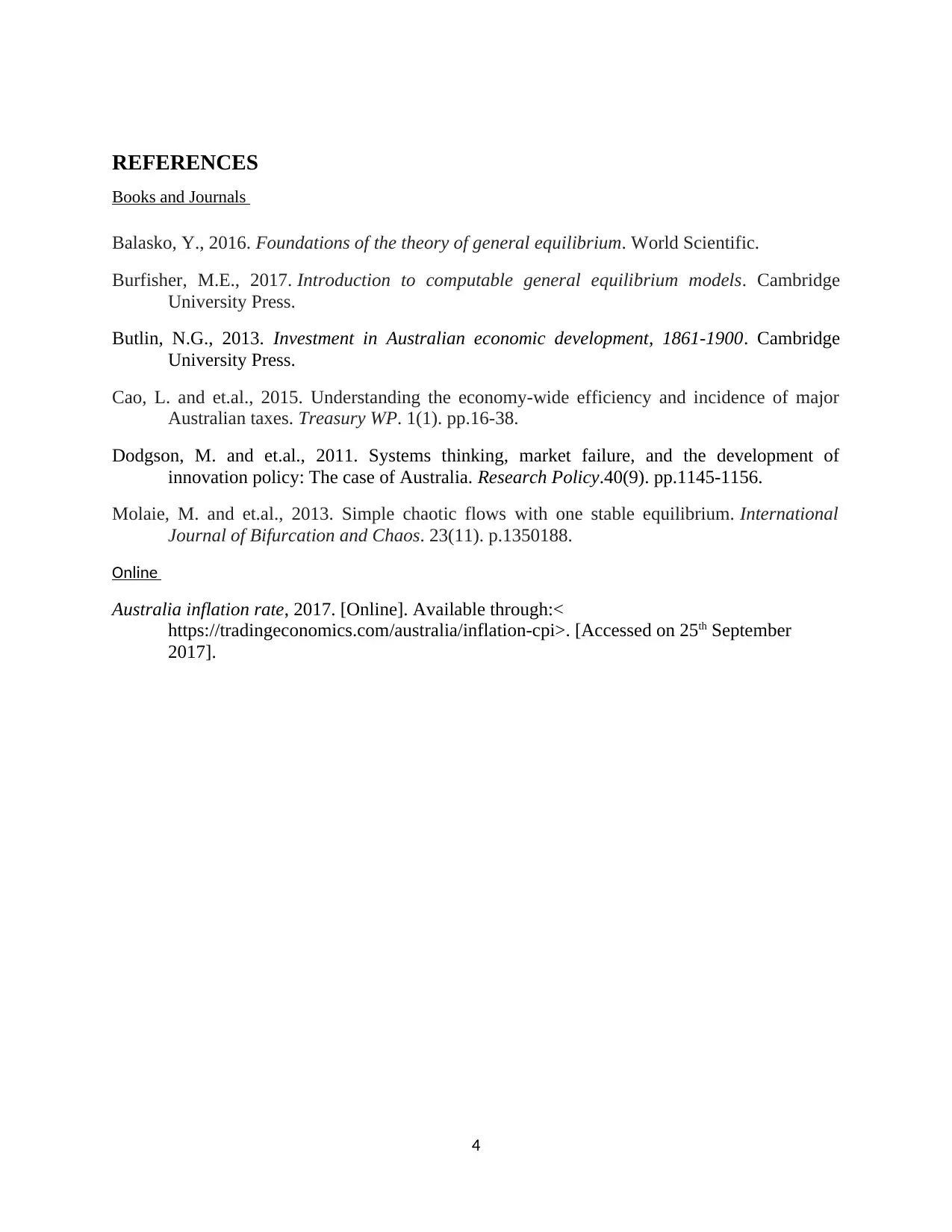
REFERENCES
Books and Journals
Balasko, Y., 2016. Foundations of the theory of general equilibrium. World Scientific.
Burfisher, M.E., 2017. Introduction to computable general equilibrium models. Cambridge
University Press.
Butlin, N.G., 2013. Investment in Australian economic development, 1861-1900. Cambridge
University Press.
Cao, L. and et.al., 2015. Understanding the economy-wide efficiency and incidence of major
Australian taxes. Treasury WP. 1(1). pp.16-38.
Dodgson, M. and et.al., 2011. Systems thinking, market failure, and the development of
innovation policy: The case of Australia. Research Policy.40(9). pp.1145-1156.
Molaie, M. and et.al., 2013. Simple chaotic flows with one stable equilibrium. International
Journal of Bifurcation and Chaos. 23(11). p.1350188.
Online
Australia inflation rate, 2017. [Online]. Available through:<
https://tradingeconomics.com/australia/inflation-cpi>. [Accessed on 25th September
2017].
4
Books and Journals
Balasko, Y., 2016. Foundations of the theory of general equilibrium. World Scientific.
Burfisher, M.E., 2017. Introduction to computable general equilibrium models. Cambridge
University Press.
Butlin, N.G., 2013. Investment in Australian economic development, 1861-1900. Cambridge
University Press.
Cao, L. and et.al., 2015. Understanding the economy-wide efficiency and incidence of major
Australian taxes. Treasury WP. 1(1). pp.16-38.
Dodgson, M. and et.al., 2011. Systems thinking, market failure, and the development of
innovation policy: The case of Australia. Research Policy.40(9). pp.1145-1156.
Molaie, M. and et.al., 2013. Simple chaotic flows with one stable equilibrium. International
Journal of Bifurcation and Chaos. 23(11). p.1350188.
Online
Australia inflation rate, 2017. [Online]. Available through:<
https://tradingeconomics.com/australia/inflation-cpi>. [Accessed on 25th September
2017].
4
⊘ This is a preview!⊘
Do you want full access?
Subscribe today to unlock all pages.

Trusted by 1+ million students worldwide
1 out of 6
Related Documents
Your All-in-One AI-Powered Toolkit for Academic Success.
+13062052269
info@desklib.com
Available 24*7 on WhatsApp / Email
![[object Object]](/_next/static/media/star-bottom.7253800d.svg)
Unlock your academic potential
Copyright © 2020–2025 A2Z Services. All Rights Reserved. Developed and managed by ZUCOL.





